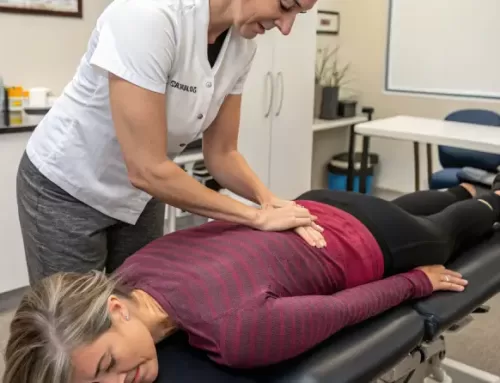Temporomandibular joint (TMJ) disorders can significantly impair daily activities, manifesting as persistent jaw pain, restricted movement, or discomfort during routine tasks such as chewing or speaking. For individuals grappling with these challenges, TMJ physiotherapy emerges as a highly effective, non-invasive treatment option. This specialized form of physical therapy targets the underlying causes of TMJ dysfunction, offering relief through tailored interventions. By integrating manual techniques, therapeutic exercises, and lifestyle modifications, TMJ physiotherapy restores functionality and alleviates pain. This article provides a comprehensive exploration of TMJ physiotherapy, detailing its methodologies, benefits, and role in managing jaw pain.
Overview of the Temporomandibular Joint and Associated Pain
The temporomandibular joint serves as a critical anatomical structure, facilitating essential functions such as chewing, speaking, and facial expressions. Dysfunction in this joint, often referred to as temporomandibular disorder (TMD), can lead to debilitating symptoms. Understanding the TMJ’s anatomy and the factors contributing to its dysfunction is fundamental to appreciating the value of physiotherapy.
Anatomy and Function of the Temporomandibular Joint
The TMJ is a synovial joint that connects the mandible (lower jaw) to the temporal bone of the skull, located anterior to the ears. It operates as a hinge and sliding mechanism, supported by a fibrocartilaginous disc that cushions and stabilizes movement. This complex joint enables a range of motions, including opening and closing the mouth, lateral deviation, and protrusion. Approximately 5-12% of the global population experiences TMJ disorders, with a higher prevalence among women aged 20-40, according to clinical studies.
Primary Causes of TMJ Dysfunction
TMJ disorders arise from a variety of factors, often multifactorial in nature. Chronic stress frequently contributes, as it may lead to involuntary jaw clenching or teeth grinding (bruxism), placing undue strain on the joint. Physical trauma, such as a direct blow to the jaw or whiplash, can disrupt TMJ alignment or damage its structures. Osteoarthritis or rheumatoid arthritis may inflame the joint, while poor posture—particularly forward head positioning—can exacerbate dysfunction. Additionally, habitual behaviors like excessive gum chewing or improper bite alignment may precipitate symptoms.
Identifying Symptoms of TMJ Disorders
Recognizing the symptoms of TMJ disorders is crucial for timely intervention. These symptoms often extend beyond the jaw, affecting overall quality of life.
Key Indicators of TMJ Pain
Common manifestations include localized jaw pain or tenderness, particularly during movement. Patients may report audible clicking or popping sounds when opening or closing the mouth, indicative of disc displacement or joint irritation. Other symptoms encompass restricted jaw mobility, locking of the jaw, and referred pain manifesting as headaches, earaches, or facial discomfort. In some cases, individuals experience tinnitus or altered dental occlusion, underscoring the need for professional evaluation.
Transform Your Health with Expert Physiotherapy in Scarborough
Receive tailored treatments to alleviate pain, enhance mobility, and restore your well-being. Schedule your appointment now!
Defining TMJ Physiotherapy
TMJ physiotherapy is a specialized branch of physical therapy designed to address dysfunction in the temporomandibular joint and its associated musculature. By employing evidence-based techniques, it aims to reduce pain, enhance mobility, and improve functional outcomes. This approach prioritizes non-invasive methods, offering an alternative to pharmacological or surgical interventions.
Role of Physiotherapists in TMJ Management
Physiotherapists play a pivotal role in diagnosing and treating TMJ disorders. The process begins with a thorough assessment, encompassing a review of medical history, symptom analysis, and physical examination of jaw mobility, muscle tension, and posture. Neck and shoulder evaluations are often included, given their anatomical interplay with the TMJ. Based on this assessment, physiotherapists develop individualized treatment plans, incorporating manual therapy, exercises, and patient education to optimize recovery.
Core Physiotherapy Techniques for TMJ Pain Relief
TMJ physiotherapy employs a diverse array of techniques tailored to the patient’s specific needs. These interventions target both the joint and surrounding tissues to alleviate pain and restore function.
Manual Therapy and Joint Mobilization Techniques
Manual therapy involves hands-on techniques to mobilize the TMJ, reducing stiffness and enhancing joint glide. Physiotherapists may apply gentle oscillations or sustained pressure to the joint, promoting relaxation of tight muscles and realignment of the articular disc. These methods improve blood flow and decrease inflammation, facilitating smoother jaw motion.
Therapeutic Exercises for Jaw Functionality
Therapeutic exercises form the cornerstone of TMJ rehabilitation. Specific movements, such as the “goldfish exercise” (controlled partial mouth opening) or resisted jaw motions, strengthen masticatory muscles and enhance coordination. Chin tuck exercises, which reinforce cervical alignment, indirectly support TMJ stability. Patients are typically instructed to perform these exercises at home, ensuring consistent progress.
Soft Tissue Techniques and Dry Needling
Soft tissue techniques, including myofascial release and targeted massage, address muscle tension in the jaw, neck, and shoulders. These methods enhance circulation and alleviate trigger points, which are common in TMJ disorders. Dry needling, involving the insertion of fine needles into hypertonic muscles, may be employed to release chronic tension and promote relaxation.
Application of Heat and Cold Therapy
Thermotherapy and cryotherapy serve as adjunctive modalities in TMJ physiotherapy. Heat application, via warm compresses, relaxes muscles and improves tissue elasticity, aiding mobility. Conversely, cold therapy reduces acute inflammation and numbs pain, particularly following exacerbations. Physiotherapists may recommend alternating these therapies to maximize benefits.
✔️ Also read: Can Physiotherapy Help With Breathing Issues?
Lifestyle Modifications to Enhance TMJ Recovery
Sustainable recovery from TMJ disorders requires integrating physiotherapy with lifestyle adjustments. These modifications address contributing factors and prevent symptom recurrence.
Stress Reduction Strategies
Chronic stress exacerbates TMJ dysfunction by promoting muscle tension and bruxism. Physiotherapists often recommend relaxation techniques, such as diaphragmatic breathing, progressive muscle relaxation, or mindfulness meditation. These strategies mitigate the physiological effects of stress, reducing strain on the TMJ.
Importance of Posture and Ergonomics
Proper posture is integral to TMJ health, as forward head posture or slouched shoulders can strain the jaw and neck. Physiotherapists educate patients on maintaining neutral spinal alignment and optimizing ergonomic setups, such as adjusting workstations to minimize neck strain. These adjustments alleviate undue pressure on the TMJ, supporting long-term recovery.
Interrelation Between TMJ and Cervical Spine
The TMJ and cervical spine share a close anatomical and functional relationship, necessitating a holistic treatment approach.
Benefits of Integrated Neck and Jaw Treatment
Dysfunction in the cervical spine, such as muscle tightness or joint misalignment, can exacerbate TMJ symptoms due to shared neuromuscular pathways. Research indicates that addressing cervical issues alongside TMJ treatment enhances pain relief and functional outcomes. Techniques like cervical mobilization or strengthening exercises complement jaw-focused therapies, creating a synergistic effect.
When to Consult a Professional for TMJ Issues
While mild TMJ symptoms may resolve spontaneously, persistent or severe cases warrant professional intervention.
Critical Symptoms Requiring Immediate Attention
Symptoms such as severe, unrelenting pain, jaw locking, or swelling suggest a need for urgent evaluation. Additional red flags include non-mechanical pain, neurological symptoms (e.g., numbness), or systemic signs like fever, which may indicate underlying pathology. Prompt consultation with a physiotherapist or dentist ensures accurate diagnosis and timely treatment.
Anticipated Outcomes of TMJ Physiotherapy
TMJ physiotherapy offers substantial benefits, including pain reduction, improved jaw mobility, and enhanced quality of life.
Typical Recovery Timelines
Recovery duration varies based on the severity and chronicity of the condition. Mild cases may improve within 4-6 weeks of consistent therapy, while complex cases, such as those involving disc displacement, may require 8-12 weeks or longer. Adherence to prescribed exercises and lifestyle changes is critical to achieving optimal outcomes.
Sum Up
TMJ physiotherapy represents a robust, evidence-based approach to managing jaw pain and dysfunction. By addressing the root causes through targeted techniques and holistic strategies, it empowers individuals to regain comfort and functionality. For those experiencing TMJ-related symptoms, consulting a qualified physiotherapist offers a pathway to effective, non-invasive relief. Taking proactive steps toward professional care can significantly enhance well-being and restore ease in daily activities.
Frequently Asked Questions
- Is TMJ physiotherapy effective for all types of jaw pain?
TMJ physiotherapy is highly effective for pain stemming from muscle tension, joint dysfunction, or mild disc issues. However, cases involving structural damage or systemic conditions may require additional interventions, guided by a thorough professional assessment. - Do I need a physician’s referral to access TMJ physiotherapy?
In many regions, direct access to physiotherapy is available without a referral. Nonetheless, consulting a dentist or physician can clarify whether TMJ physiotherapy is the most appropriate course of action. - Are home-based TMJ exercises safe for self-management?
Exercises prescribed by a physiotherapist are generally safe when performed as instructed. Patients should avoid overexertion and consult their therapist if discomfort arises during home exercises. - How does stress management complement TMJ physiotherapy?
Stress management reduces muscle tension and bruxism, which are common TMJ triggers. Techniques like mindfulness or breathing exercises, often integrated into physiotherapy, enhance treatment efficacy. - Can TMJ physiotherapy alleviate associated headaches?
Yes, by addressing jaw and neck tension, TMJ physiotherapy can reduce headaches caused by referred pain or muscle strain, offering comprehensive symptom relief.




